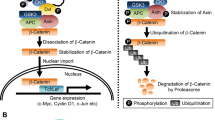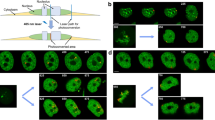Summary
The microtubules ofPhysarum amoebae have been decorated with rat antibodies against yeast tubulin. The indirect fluorescent staining observed in interphase amoebae and in flagellated amoebae is consistent with the three-dimensional reconstructions previously deduced from electron microscopic studies. Mitotic amoebae exhibit a pattern of fluorescence which is similar to that exhibited by mammalian cells and is consistent with the previous electron microscopic studies, except that we also observe pole-pole microtubule fibers during metaphase and anaphase and the presence of a typical midbody during cytokinesis. The various types of tripolar mitosis which are observed suggest that there is a regulatory mechanism allowing the formation of pseudo-bipolar mitotic apparatuses in amoebae possessing more than two mitotic centers during mitosis. The mitotic center, located in the middle of the centrosphere, is not fluorescent after staining of the monoasters induced with taxol suggesting the absence of tubulin in the mitotic center.
Similar content being viewed by others
References
Aldrich, H. C., 1969: The ultrastructure of mitosis in Myxamoebae and plasmodia ofPhysarum flavicomum. Amer. J. Bot.56, 290–299.
—,Daniel, J. W., 1982: Cell Biology ofPhysarum andDidymium, Vol. 1 and 2. New York: Academic Press.
—,Mims, C. W., 1970: Synaptonemal complexes and meiosis inMyxomycetes. Amer. J. Bot.57, 935–941.
Brinkley, B. R., Fuller, G. M., Highfield, D. P., 1976: Tubulin antibodies as probes for microtubules in dividing and non dividing cells. In: Cell Motility (Goldman, R., Pollard, T., Rosenbaum, J., eds.), pp. 435–456. New York: Cold Spring Harbor Lab.
—,Fistel, S. H., Marcum, J. M., Pardue, R. L., 1980: Microtubules in cultured cells; indirect immunofluorescent staining with tubulin antibody. Int. Rev. Cytology63, 59–95.
Cadman, E. J., 1931: The life-history and cytology ofDidymium nigripes. Trans. Roy. Soc. Edin.57, 93–142.
Chang, M. T., Dove, W. F., Laffler, T. G., 1983: The periodic synthesis of tubulin in thePhysarum cell cycle: Characterization ofPhysarum tubulin by affinity for monoclonal antibodies and by peptide mapping. J. biol. Chem.258, 1352–1356.
Cohen, J., Adoute, A., Grandchamp, S., Houdebine, L. M., Beisson, J., 1982: Immunocytochemical study of microtubular structures throughout the cell cycle ofParamecium. Biol. Cell.44, 35–44.
Cooke, D. J., Dee, J., 1975: Methods for the isolation and analysis of plasmodial mutants inPhysarum polycephalum. Genet. Res. Camb.24, 175–187.
Gallo, J. M., Schrevel, J., Anderton, B. H., 1982: A monoclonal antibody specific for the tubulin ofTrypanosomes. Biol. Cell.45, 265 (644).
Goodman, E. M., 1982: Myxamoebae: structure and physiology. In: Cell Biology ofPhysarum andDidymium, Vol. 2 (Aldrich, H. C., Daniel, J. W., eds.), pp. 101–128. New York: Academic Press.
Guttes, S., Guttes, E., Ellis, R. A., 1968: Electron microscope study of mitosis inPhysarum polycephalum. J. Ultrastruct. Res.22, 508–529.
Hill, A. M., Maunoury, R., Pantaloni, D., 1981: Cellular distribution of the microtubule-associated proteins HMW (350 K, 300 K) by indirect immunofluorescence. Biol. Cell.41, 43–50.
Kerr, S. J., 1967: A comparative study of mitosis in amoebae and plasmodia of the true slime moldDidymium nigripes. J. Protozool.14, 439–445.
Kilmartin, J. V., Wright, B., Milstein, C., 1982: Rat monoclonal antitubulin antibodies derived by using a new non secreting rat cell line. J. Cell Biol.93, 576–582.
McIntosh, J. R.,Cande, Z.,Snyder, J.,Vanderslice, K., 1975: Studies on the mechanism of mitosis. In: The Biology of Cytoplasmic Microtubules (Soifer, D., ed.). Ann. N.Y. Acad. Sc.253, 407–427.
Mir, L., Moisand, A., Wright, M., 1983 a: Unusual amoebal strains of the MyxomycetePhysarum polycephalum possessing one or two pro-flagellar apparatuses. Protoplasma118, 124–134.
- - - 1983 b: Isolation and characterization of amoebal strains of the MyxomycetePhysarum polycephalum possessing one, two or three flagellar apparatuses: the role of the centrioles and of the microtubule organizing centers 1 during mitosis. Protoplasma (in press).
Parness, J., Horwitz, S. B., 1981: Taxol binds to polymerized tubulinin vitro. J. Cell. Biol.91, 479–487.
Ring, D., Hubble, R., Kirschner, M., 1982: Mitosis in a cell with multiple centrioles. J. Cell Biol.94, 549–556.
Schiff, P. B., Fant, J., Horwitz, S. B., 1979: Promotion of microtubule assemblyin vitro by taxol. Nature277, 665–667.
Wilson, M., Cadman, E. J., 1928: The life history and cytology ofReticularia lycoperdon. Trans. Roy. Soc. Edin.55, 555–608.
Wright, M., 1982: The microtubular systems in the amoebal and plasmodial forms ofPhysarum polycephalum (Myxomycetes). In: Microtubules in Microorganisms (Cappuccinelli, P., Morris, N. R., eds.), pp. 203–225. New York: Marcel Dekker.
—,Moisand, A., Mir, L., 1979: The structure of the flagellar apparatus of the swarm cells ofPhysarum polycephalum. Protoplasma100, 231–250.
—,Mir, L., Moisand, A., 1980 a: The structure of the pro-flagellar apparatus of the amoebae ofPhysarum polycephalum: relationship to the flagellar apparatus. Protoplasma103, 69–81.
— — —, 1980 b: Centriole maturation in the amoebae ofPhysarum polycephalum, Protoplasma105, 149–160.
— —,Oustrin, M. L., 1982 a: Stabilization of monoasters by taxol in the amoebae ofPhysarum polycephalum, (Myxomycetes). Protoplasma113, 44–56.
— —, 1982 b: Spatial relationships between centrioles and the centrospheres in monoasters induced by taxol inPhysarum polycephalum amoebae. Protoplasma113, 69–79.
Youngman, P. J., Anderson, R. W., Holt, C. E., 1981: Two multiallelic mating compatibility loci separately regulate zygote formation and zygote differentiation in the MyxomycetePhysarum polycephalum. Genetics97, 513–530.
Author information
Authors and Affiliations
Rights and permissions
About this article
Cite this article
Lemoine, A., Mir, L. & Wright, M. Indirect immunofluorescent staining of the microtubules in interphase and mitotic amoebae of the myxomycetePhysarum polycephalum . Protoplasma 120, 43–50 (1984). https://doi.org/10.1007/BF01287616
Received:
Accepted:
Issue Date:
DOI: https://doi.org/10.1007/BF01287616




